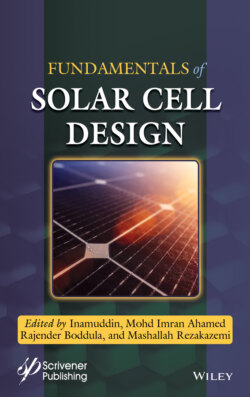Читать книгу Fundamentals of Solar Cell Design - Rajender Boddula - Страница 39
2.4.1 Direct Plasmonic Solar Cells
ОглавлениеThe direct plasmonic solar cells utilize plasmonic nanoparticles as active light absorbers. The hot charge carriers in plasmonic nanoparticles can be produced by excitation of SPR. The hot electrons can be introduced into semiconductor for converting sunlight into electric energy and hot holes can also be injected into a p-type semiconductor. The separation of charge carriers makes possible to use plasmonic nanostructures directly as photo absorbers. The metallic nanoparticles such as Au and Ag offers plasmonic band in visible range that can act as light harvesting antenna. Yocefu Hattori and Jacinto Sa have demonstrated direct plasmonic solar cell using gold surface plasmons [46]. Peafowl solar power company, a spinout company from Uppsala University, Sweden, has started to develop direct plasmonic transparent solar cells for commercial applications. The device configuration of this plasmonic solar cell is similar to traditional thin film PV cell. These plasmonic solar cells were manufactured inexpensively through a printing process at room temperature which can convert the light into electricity under very low light [47–49].
Figure 2.6 The device configuration of (a) direct and (b) plasmonic enhanced plasmonic solar cell and (c) plasmonic DSSC.
Figure 2.7 Efficiency for various plasmonic solar cell technology.
Table 2.3 Effect of various plasmonic nanostructures on solar cell technologies.
| Solar cell technology | Plasmonic nanostructure | Mechanism | Efficiency (%) | Reference |
| Hot carrier cell | Au@TiO2/PEDOT | Direct plasmonic transparent active layer | 0.2 | [46] 2019 |
| Au | Direct plasmonic as active layer | 24 | [59] Wu, 2013 | |
| Silicon | Ag with diameter 14-100 nm | At top surface | 26 | [27] Atwater HA, 2010 et al., 2010 |
| Al | At top of surface | 14.5 | [53] 2013 | |
| Au | At top of surface | 14 | [115] Jacak, 2018 | |
| Ag | At top of surface | 12.8 | [115] Jacak, 2018 | |
| GaAs | Ag | At top of surface | 22.15 | [94] 2019 |
| Ag | At top surface | 5.9 | [51] 2008 | |
| CIGS | Au | At top surface | 4 | [61] Londhe, 2016 |
| Ag | At top surface | 9.44 | [115] Jacak, 2018 | |
| Au | At top surface | 10.34 | [115] Jacak, 2018 | |
| CdTe | Au | At top surface | 9 | [62] Kim, 2015 |
| CZTS | Au | At back surface | 9 | [64] Omar, 2018 |
| DSSC | Ag | Embedded with TiO2 | 3.62 | [85] 2017 |
| Au (15 nm) | Embedded with TiO2 | 4.46 | [73] 2014 | |
| PEC | Au@TiO2 | Emdded with TiO2 for oxygen evolution | 40 (H atom per electron) | [88] 2012 |
| Quantum dot | Ag@PdS | At top surface | 6.03 | [114] Kawawaki, 2015 |
| Au@PbS | At top surface | 9.58 | [81] Chen, 2018 | |
| CdS@GaAs | At top surface | 18.9 | [82] Lin, 2012 | |
| Perovskites | Ag | At top surface | 13.46 | [107] Aliaksandr, 2018 |
| Ag@TiO2 | Embedded with TiO2 | 16.3 | [113] Saliba, 2015 | |
| Au@coreshell | Embedded with core-shell structure | 19.42 | [87] 2020 | |
| Hybrid plasmonic | Au@AuQD:organic | At top surface | 13 | [83] Phetsang, 2019 |
| Ag@TiO2@Pa | Embedded with core-shell structure | 20.2 | [86] 2019 | |
| Au@ZnO:OEC | Embedded | 10.5 | [89] 2016 |
